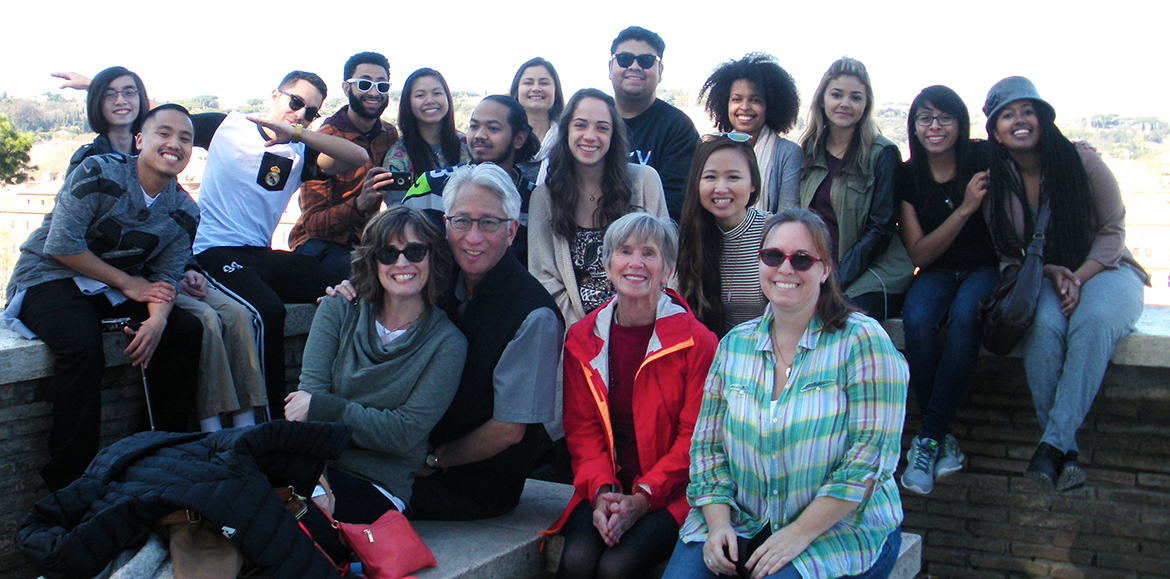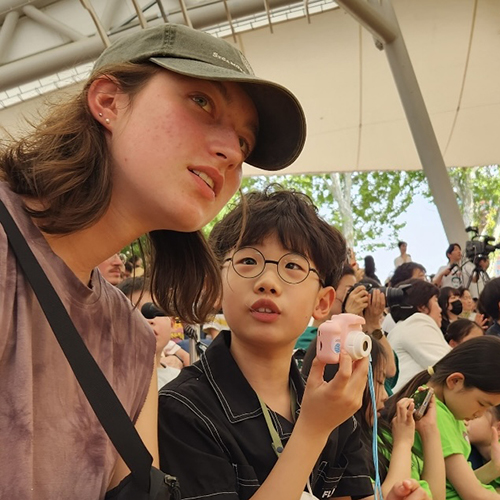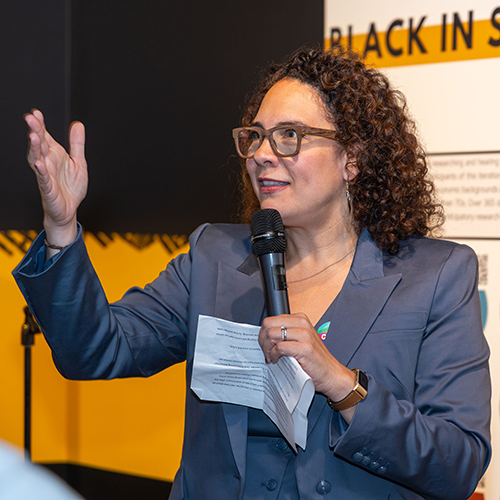A statue of the philosopher Giordano Bruno stands prominently in the Campo di Fiore in Rome. UW student Jordan DeSanto stands at the philosopher’s feet and teaches me, Professor Shawn Wong (English/ Comparative Literature) and 13 UW students about Bruno’s fate — burnt at the stake in 1600 for heresy, having forsaken the conventional view of the universe for one that includes multiple suns. To help us appreciate Bruno’s significance, Jordan has us imagine ourselves back in the UW’s Red Square where we might advocate for an unpopular cause. Jordan is a born teacher.
I am here with this group of students from the UW’s Office of Minority Affairs and Diversity (OMA&D) because I too am a teacher, long retired, but maintaining interest by my involvement with the UW’s College of Arts & Sciences Board. When I invited Shawn Wong to a March lunch as a part of the Board’s "Take a Professor to Lunch" initiative, he invited me to lunch in Rome, where he would be leading a two-week spring break humanities course for OMA&D students. It was an invitation I couldn’t pass up.

The students include ten from UW Seattle and two each from the Tacoma and Bothell campuses, ages 20-45. One has flown only once to Chicago. Another emigrated from Nicaragua. Thanks to generous patrons, each student pays $500 for a 10-day humanities course, where the ruins of Rome are their classroom.
Each of us has researched and prepared a 15-minute on-site historical talk on monuments from the Spanish Steps to the Pantheon. The students are well prepared to enlighten us about cultural icons they are seeing for the first time. Shawn had assigned me Via Giulia, a historic street near the UW Rome Center. Explicating Michelangelo’s arch to San Sebastian, I am once again a high school teacher. We are standing at the beginning of the Italian Renaissance. Students gather under my classroom voice as they have for each other, and they applaud my lessons on the steps of the final cathedral.
An industrial engineering student fills her water bottle at a public fountain near the Vatican Museum. “Look at those aqueducts, Mary. Thousands of years ago, the Romans got it right. Can we?”
Academic majors represented in our group include engineering, cultural anthropology, psychology, education, finance and more. I expect to hear analogies to their majors, but this is a class in the humanities. How does art and culture elevate our human existence? These students model humanity.
The second week each student teaches an aspect of modern Italy. What do they want to research? How has Italy welcomed refugees? How do the disabled negotiate this cobblestoned, ancient city? Aurelia, an industrial engineering student, fills her water bottle at a public fountain near the Vatican Museum. “Look at those aqueducts, Mary. Thousands of years ago, the Romans got it right. Can we?” Heather, studying global engagement at UW Tacoma, sees a beggar kneeling on cobblestones, hands thrust out in supplication. Heather compares homelessness in Rome and Seattle. For her modern Italy research project, she will report on Italian Human Services.
All of the students are ethnic or underrepresented minorities. Most are the first in their family to attend college. One, a 45 year-old mother of three, is restarting her independent life. Traveling “alone” is a testament of courage for her. Juan saved money from his part-time job for tuition and for a soccer game in Rome.

Feben stands in the Jewish ghetto presenting for us a history of persecution that goes to the founding of Rome. Her dark skin and long braids are as elegant as Cleopatra’s. Her voice quivers with empathy as she recounts the Nazi evacuation of families on the spot where she stands. We are silent. By skin color alone, we are a mini United Nations. I cannot resist inserting my English teacher self. I reference Shylock and Christian dependence upon and persecution of moneylenders. Expressions on students’ faces indicate that some do not know Shakespeare’s The Merchant of Venice. I encourage them to take literature and art history classes before graduation. The Rome experience takes them to museums such as the Borghese Gallery, the Vatican Museum, and to churches where Renaissance masterworks hang in intended sites. Having seen the best of both Bernini and Caravaggio in Rome, they will shine in art history.
The group remains for ten days. I leave after seven. As my plane rises above clouds, I imagine the students back in Rome. It is their free day. Many take the train to Florence, Cinque Terra, Tivoli, and Sperlonga. Others attend church services, the Roman flea market, exploring Rome’s entangled streets. As evening comes, they take turns cooking for each other, sharing meals made from fresh vegetables they buy in the Campo de’Fiori below their apartments at the Rome Center.
Shawn’s wife, poet Erin Malone, teaches creative writing. She instructs the group to select one of their photographs each day to post on the group Facebook page with descriptions that use all senses to communicate tactile location. I will read these for days after returning home.
Professor Jim Clauss (Classics) and Shawn Wong have taken turns teaching the OMA&D session at the UW Rome Center for many years. They are inviting all students to explore the humanities. Better than taking a professor to lunch, I was able to experience what one teaches at the Rome Center, an extension of campus some 5,000 miles east of cherry blossoms blooming in the Quad.
More Stories

Democracy by the Numbers
Mathematics and Democracy, an undergraduate mathematics course, explores the role of math in many aspects of democracy, from elections to proportional representation.

Finding Family in Korea Through Language & Plants
Through her love of languages and plants — and some serendipity — UW junior Katie Ruesink connected with a Korean family while studying in Seoul.

Interrupting Privilege Starts with Listening
Personal stories are integral to Interrupting Privilege, a UW program that leans into difficult intergenerational discussions about race and privilege.